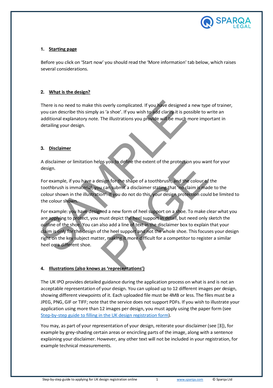 The time it takes to register a design will depend on where you are applying to register your design; in the UK or in the EU. Delays in registering a design can be avoided by carrying out a thorough search before applying to ensure your design is sufficiently new and individual and by taking care when filling out the application form.
The time it takes to register a design will depend on where you are applying to register your design; in the UK or in the EU. Delays in registering a design can be avoided by carrying out a thorough search before applying to ensure your design is sufficiently new and individual and by taking care when filling out the application form.
You can find our step-by-step guide to applying for UK design registration online here. You can also purchase this guide as part of our Protecting IP and Confidential Information toolkit.
How long it takes to register a design in the UK
The UK Intellectual Property Office will usually look at your application within two weeks of receiving it. If there are no issues with your application, your design will be registered and published immediately in the Designs Journal.
If you have made a request in your application for the date of registration and publication to be deferred for up to 12 months (for example, if you want to spend more time setting up a marketing campaign before releasing a new product), the design will be published on the deferred date. You must notify the UK Intellectual Property Office when you want registration to take place using Form DF2C.
If there is a problem with your application, the process will take longer. If your application is unsuccessful, you have several options if you decide that you want to proceed with your application:
- You can ask the registrar to reconsider their initial decision. You will have two months after the date of the decision to respond to the registrar’s refusal, which must be made in writing to the UK Intellectual Property Office. If, after reconsidering the initial decision, the registrar refuses to register your design again, you can appeal the final decision. You have between 14 days and 6 weeks to lodge your appeal with the relevant authority.
- You can re-apply with a slightly different design, which may be cheaper, quicker and easier.
How long it takes to register a design in the EU
The EU Intellectual Property Office (EU IPO) will usually register your design within a couple of days of your online application.
If you have requested the date of publication to be deferred for up to 30 months, your design will be registered immediately, and your details including the filing date, registration date, your name and the fact that the design has been deferred will be published. The actual design will be published on the deferred date.
If there is a problem with your application, the process can end up taking some months. For example, the EU IPO may require additional information or may require you to amend your application. If so, they will write to you to explain what must be done and you must make these changes within two months of receiving the statement. An extension will normally be granted automatically if requested, but second extensions are unlikely to be granted. If you do not remedy the problem or provide the requested information in time, your application will be struck off.
If your application is unsuccessful, you can appeal the decision. If you decide to appeal, you have two months from the decision in which to lodge the appeal. It is often cheaper, quicker and easier to make changes to your design or application form and then re-apply.
Avoiding delays when registering a design
In order to avoid delays when registering your design, it is important to avoid any of the pitfalls of the application process.
Make sure that your design qualifies for registration before applying. This means checking to ensure that the design is sufficiently new and individual. If you are unsure whether you can apply to register a design in a particular product, you can search the online EuroLocarno Database for it. If the product category is in the database, this means it is possible to register a design for it. See our Q&A for further guidance on what designs are registrable in both the UK and the EU.
In both the UK and the EU, you can apply to register multiple designs in one application form which can assist in saving time.
The content in this article is up to date at the date of publishing. The information provided is intended only for information purposes, and is not for the purpose of providing legal advice. Sparqa Legal’s Terms of Use apply.

Marion joined Sparqa Legal as a Senior Legal Editor in 2018. She previously worked as a corporate/commercial lawyer for five years at one of New Zealand’s leading law firms, Kensington Swan (now Dentons Kensington Swan), and as an in-house legal consultant for a UK tech company. Marion regularly writes for Sparqa’s blog, contributing across its commercial, IP and health and safety law content.






